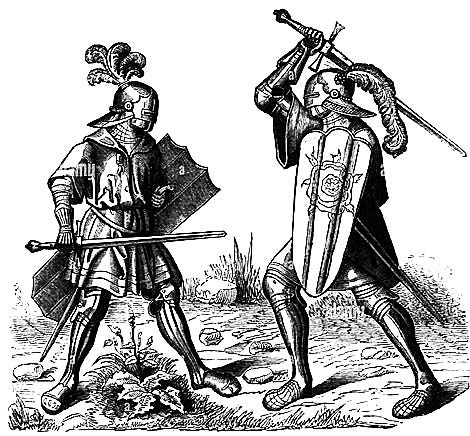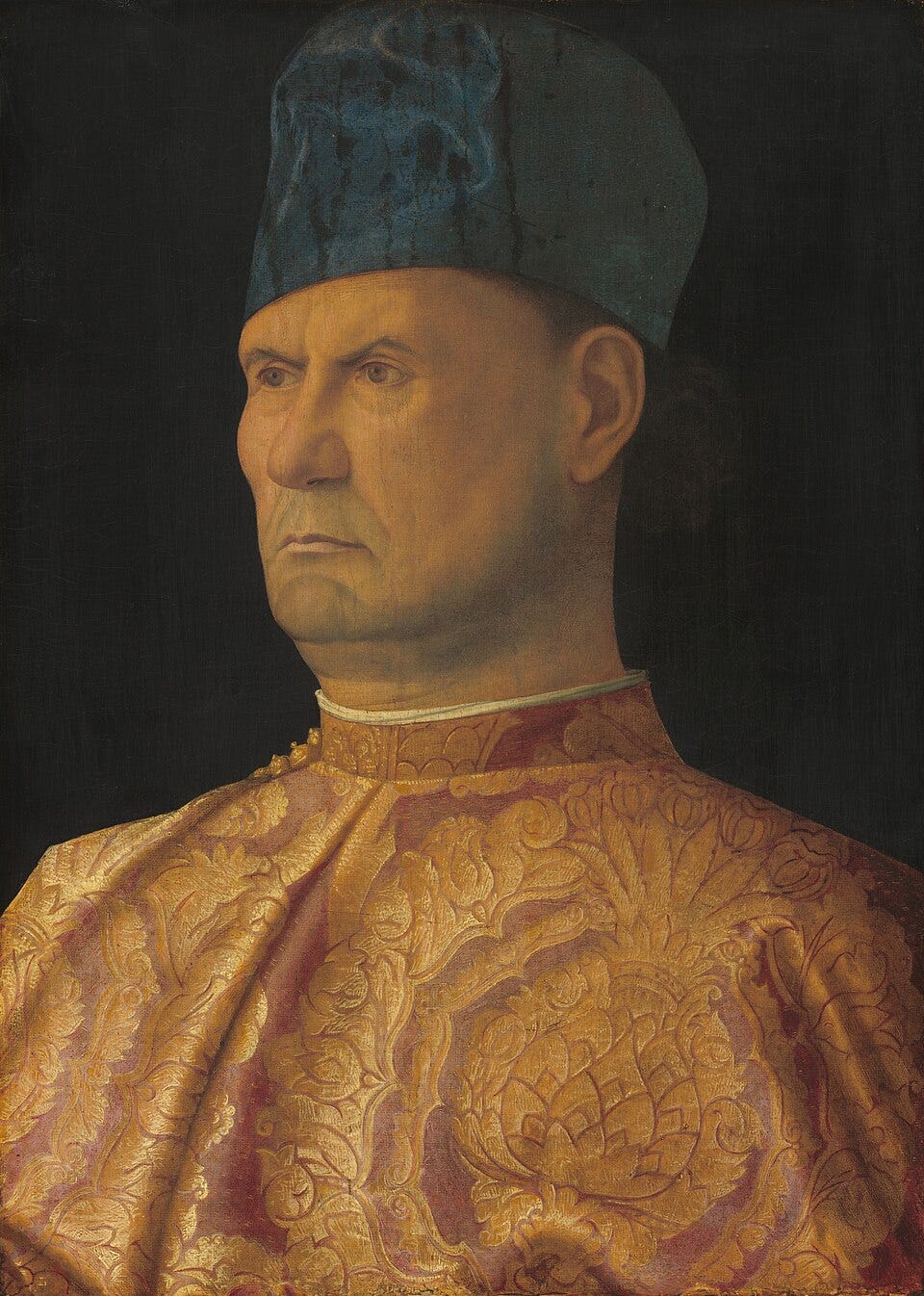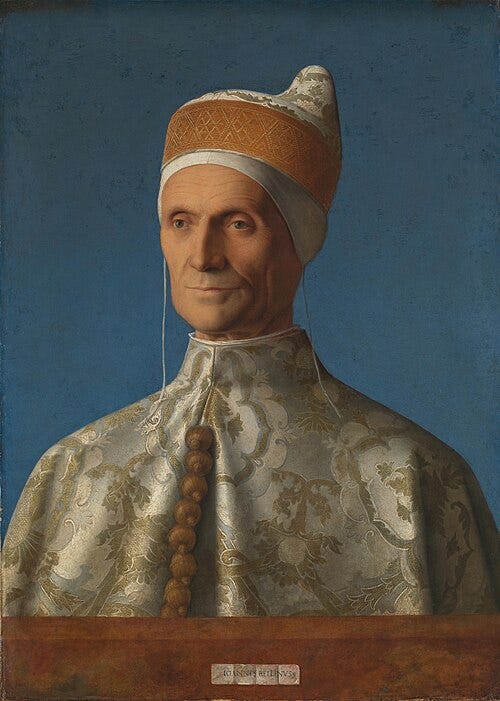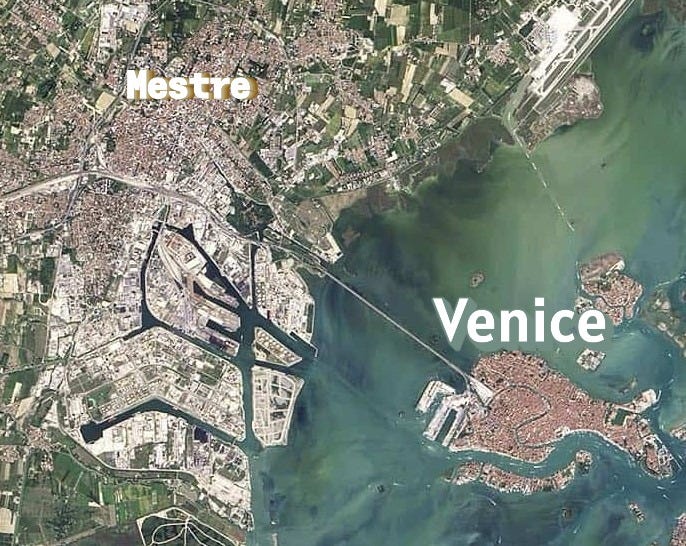In the spring of 1513 Northern Italy was once again buffeted by the winds of war after six fragile months of peace. Armor came out of the cupboards and squires stripped off the grease; warhorses and their men-at-arms were whipped back into a fighting trim. The great cities rang with the cry of hammers banging out spare horseshoes, new pike heads, new bill hooks, and bolt tips by the thousands.
This fresh war found Hugo Pepoli and Guido Rangoni once again in the service of the Republic of Venice, along with Guido’s relatives from Bologna, the Bentivoglio.[1] Guido Rangoni commanded one of the top companies of men-at-arms in the Venetian army, along with a large scouting force of mounted crossbowmen. Hugo Pepoli was the lieutenant to the overall commander of the Venetian army, John Paul Baglioni. Or at least Baglioni had been the overall commander.
There was a new sheriff in town named Bartholomew d’Alviano. He was taking total command of the Venetian army.
The teams had changed once again. Venice now found itself allied with her former enemy, France. Opposing them were the forces of the so-called Holy League: Spain, the German Empire, the Swiss, and of course, the new Pope, Leo X.
The General
Alviano had been a prisoner of the French for the last four years. This new alliance between the French and Venice set him free. Venice gladly took him back as generalissimo of the Venetian army.
Alviano was no statesman, no courtly commander wrapped in silk and ceremony. He was a short, brutish figure, scarred by war and hardened by years of captivity. His temper was fiery, his will unyielding, and his vision for Venice’s military was nothing short of revolutionary. A survivor of the catastrophic Battle of Agnadello four years before, Alviano had endured years in captivity with a ransom so great that even wealthy Venice could not afford it.
While his body remained trapped in captivity, his mind soared. During imprisonment he drafted grand designs for a Venetian army that could hold its ground against the mightiest invaders. He had scrawled his ideas on scraps of whatever he could find—even toilet paper.
Now, finally free, he was determined to bring his vision to life. He traveled east towards the Venetian army, meeting his principal officers, and sizing up his command. Then he went to Venice to meet with the Doge and receive the staff and banner of the Captain General of the Venetian army.
“Do You Even Want To Win?”
Alviano had not been impressed with his new army. Few commanders met his high standards. Among these were Hugo Pepoli’s boss, a man who was “wise” but also “insubordinate.” Alviano did take a shine to the fierce Guido Rangoni, whom he noted, was still “young” but showed “promise.”[2]
As for the rest? Worthless. With barely concealed disgust, he asked the Doge of Venice, “Do you even want to win?”
Alviano had every reason to be frustrated. The Italian art of war placed great emphasis on skirmishing and personal prowess, but as one historian later noted, “…this emphasis on individual skill and accomplishment was harmful to the development of national armies based on mass.”[3] A strategy based upon fortifications and skirmishing was limited. The future would belong to those who could put successful armies in the field, especially powerful forces of infantry.
In an infantry formation individual skill mattered far less than discipline. Victory came from, “keeping one’s courage and holding one’s place, even if it will cause death.”[4]
And discipline was precisely where the Venetians failed. Chaos reigned among their ranks. The light cavalry was good, but the infantry was laughably ill-disciplined compared to the hardened professionalism of the Spanish foot or the fearless discipline of the Swiss.
The men-at-arms were decent fighters but poorly led. Alviano seethed at their incompetence, nothing critically that, “The King of France doesn't give his top commanders more than 50 or 100 lances, but Venice gives so many to these [inadequate] men.”[6]
It was the infantry that concerned Alviano the most. Instead of professionals in continual service, Venice hastily assembled most of their infantry force for each campaign. Often these foot soldiers fought not with pikes but just with “whatever weapons they happened to have become familiar with.” [7] Worse, there was little to no chain of command between a captain and his troops—companies of a thousand or more lacked the structure necessary for true battlefield discipline. Alviano envisioned a modern army, one built upon the foundation of strong intermediate leaders who could impose order on the battlefield, picked men who would not lose their courage when the going got rough. With such a “stiffening of NCO’s,” Alviano hoped to make battle more a “test of skill and preparation and less a game of fortune.” [8]
Marching Orders
But Fortune was unkind to Alviano. Before he could start on his reforms Venice ordered him to lead his troops and unite with the French army descending into Italy. But before he could link up with the French, a powerful force of Swiss attacked the French, routed them and chased them back over the Alps into France itself.
With the French routed, Venice found itself alone.
Surrounded, outnumbered, and abandoned, Alviano understood the peril of his position. His army was small—600 men-at-arms, 1,000 light cavalry, and just 5,000 infantry. It was a force woefully insufficient to stand against the might of the Spanish, Germans, and Papal forces now bearing down upon them. Wasting no time, Alviano ordered an eastward retreat, abandoning his heavier artillery to quicken the pace.[9] His only salvation was the sluggishness of the Spanish, who were momentarily distracted by their own ambitions in Genoa.[10]
Thanks to this delay, Alviano managed to withdraw his army to Padua, effectively the southern bastion for the city of Venice. Alviano dispatched Hugo Pepoli and John Paul Baglioni to Treviso – Venice’s northern bastion.
Venice’s fate once again rested on these twin fortresses.[11]
As the Spanish, Germans, and Papal contingents advanced, they set their sights on Padua. They hoped to quickly storm into the city and take it, then press on to Venice itself. For four relentless years, Venice had rebuilt its defenses in Padua with a singular focus: survival. The devastation of 1509 had been erased, replaced by fortifications stronger than ever before. Massive bastions loomed over the landscape, designed to withstand the unforgiving bombardment of enemy artillery.[12] A half-mile-wide earthwork, gently sloping yet impenetrable, encircled much of the city, able to absorb the shock of cannon fire.[13] If this were not preparation enough, Alviano had ordered every structure within three miles of Padua to be reduced to rubble, ensuring the enemy would find neither shelter nor cover.
Now, as the storm of war broke over Padua, the question remained—would these fortifications be enough? These cities were more than strongholds. They were the last hope of Venice. Could the Republic still stand strong though she was exhausted after years of war. Or would she be forced to bend the knee to Rome and its allies?
The whole garrison from Alviano down to the lowest ditch digger knew that from Padua there could be no retreat.
Fury, Checked
But there was good news. The Spanish had the finest infantry in Europe and perhaps the best army, but no one ever offered glowing praise for the artillery of Spain. The Germans had fine cannons, but Emperor Maximilian was keeping his big guns at home this time.
Four years earlier, with walls weaker and resources scarcer, Venice had faced a siege of terrifying scale. There they had turned away a great force armed with mighty cannon. Now, in 1513, a new enemy stood before them—the Spanish and the Germans. But the Holy League lacked the mighty artillery required to force a breach in the modern walls of Padua or Treviso.
Desperate, they turned to the Duke of Ferrara, Venice’s long-standing rival and the master of the finest artillery in all of Italy. If he lent them his guns, Padua’s fate might be sealed. But after being burned by the Pope before, the duke was sitting this fight out. [14]
So the Spanish-German army arranged themselves outside the walls impotent yet savage. They ravaged and plundered Venetian lands as well as they could manage. Nor was the garrison of Padua still—Guido Rangoni and other cavalry commanders launched countless raids on the besiegers. On one raid Guido left Padua with his brother and attacked some enemies looting in the countryside. As Sanuto records:
“The enemies are still in their usual position at Albarè, and today Count Guido Rangon went out with some cavalry and 70 men-at-arms with his brother, Count Francesco, and engaged a squadron of enemies, skirmishing up to the Bassano bridge, and our forces retreated. Upon seeing the enemies, our troops fired several cannon shots. They must have killed many of them, as some of our men captured 20 enemy cavalry along with some boys who were looting.”[15]
Mestre
The enemy, unable to conquer Padua or Treviso, turned to another tactic—humiliation. If they could not defeat Venice on the battlefield, they would make her bleed in other ways. A captured Spanish spy, interrogated in late September 1513, revealed their sinister plan:
“…the Spaniards intend to come to Mestre and burn everything…”[16]
Mestre. A small town only five miles (8KM) across the lagoon from Venice itself. Unlike the fortresses of Padua and Treviso, Mestre lacked modern defenses. Worse still, it was teeming with thousands of refugees—innocent men, women, and children who had fled the devastation of war, hoping that the town’s proximity to Venice would offer them protection.
Alviano, upon learning of the enemy’s shift in strategy, was enraged. He demanded battle. He promised victory. But the Venetian government, weary and stretched thin, refused. They had neither men nor money to spare. Their priority was clear: Padua and Treviso had to hold.
Mestre would have to fend for itself.
The most Alviano could do was dispatch his fiercest young general, Guido Rangoni, in a desperate attempt to stop them. Rangoni and his cavalry cut through enemy lines around Padua, now denuded of men as their army marched toward Mestre. He struck at the Spanish and Germans as they laid waste to the land, but he may as well have been attacking a blaze with a single pail of water. [17]
As the invaders descended upon Mestre, the people of Venice could do nothing but watch.
The great city, proud and defiant for centuries, was now forced into helplessness. Citizens climbed the bell tower of San Marco, watching in horror as the enemy set fire to everything in their path. A Venetian witness recorded the scene:
“I went to the top of the bell tower of San Marco, which is being renovated at the top, at 10 PM. From there, I witnessed the great cruelty of the enemies. If they were Turks, they could not have been worse. First, I saw huge fires towards Gambarare, then at the inn of Liza Fusina and other houses, and at Moranzan, and everywhere there were massive fires with great smoke. I saw the sun at 11 PM, completely red, looking like blood due to the smoke from so many fires. Many groups went to see these fires. It was reported throughout the city that the enemy camp was crossing the Brenta, burning everything in their path, and tonight they will burn Mestre and all the villages and houses they find. No provision [for defense] is being made!” [18]
Mestre fell quickly. It had almost no professional soldiers, and its walls were not strong enough to resist the invader. The Spanish stormed the town and unleashed their fury upon those left behind. The cries of the innocent rang across the lagoon—desperate, agonized wails of men, women, and children being slaughtered without mercy. Those who took their boats onto the water could hear it, could smell it.
Still Venice could do nothing.
And then, the Spanish delivered their final insult. Dragging ten cannons to the shore, they turned their weapons not on Mestre—but on Venice itself.[19] A barrage of cannon fire echoed across the lagoon. The damage was minimal, but the message was clear. Venice, the Queen of the Adriatic, was soft and impotent.
“To Arms!”
Yet despite all their destruction, the Spanish and Germans had made one fatal miscalculation: they had overstayed their supplies. Now food and forage were running low and the land they had ravaged could no longer sustain them. The plunder was rich, but it would not feed an army. Reluctantly, they began their retreat.
Now, at last, Alviano was given his chance.[20]
Venice was seething. The enemy had dared to massacre Venetian citizens within sight of the lagoon. They had looted their lands, humiliated them, and fired upon their very home. The entire city boiled with rage. Nobles pulled rusting armor from their storerooms. Ordinary men, once hesitant, now surged toward the recruiters, demanding vengeance. The size of the army swelled almost overnight.
Venice had been humiliated. Now, she would show her enemies that the lion still had claws.
Alviano, no longer held back by the government’s hesitation, prepared for war. He knew his foe was weakened. His intelligence reports confirmed that Spanish and German morale had collapsed, that hunger gnawed at their strength. Guido Rangoni and his raiders struck at the enemy’s supply lines, cutting off the provisions they so desperately needed for their long march home.
In a church in Padua, Alviano gathered his commanders for war. There, in a solemn yet electric atmosphere, they drew lots to determine who would have the honor of leading the attack. The moment had arrived.
Alviano kept the battle cry simple, yet it rang through the halls like a thunderclap:
“To Arms!”
The army erupted with newfound energy. As they left Padua, their spirits were high, their purpose unshakable. Alviano himself felt the thrill of impending victory. John Paul Baglioni’s forces were marching from Treviso to join him. Once they combined their armies, they would outnumber the enemy.
On paper, Alviano’s army was superior. Yet half of his infantry were fresh recruits—citizens driven by fury rather than experience. They were not soldiers fit for open battle. They were best suited for digging trenches, guarding supply lines, standing watch on the city walls, anything but facing battle-hardened Spanish and German troops in the open field. As he watched his own forces he must have thought of Vegetius, “A handful of men, inured to war, proceed to certain victory, while on the contrary numerous armies of raw and undisciplined troops are but multitudes of men dragged to slaughter.”[21]
Alviano knew this.
As he rode forth with Guido Rangoni to rendezvous with Hugo Pepoli and John Paul Baglioni’s army, one question remained to him—how could he beat the enemy’s superior army with this force?
The answer would soon be written in fire and blood.
[1] See Imprese miltiare by Paolo Giovio, pp.66-67. For description
[2] Sanuto, Vol. XVI, col. 240.
[3] Mallett & Hale, p.258.
[4] Altoni, p.11
[5] Sanuto, Vol. XIV, cols. 558-559.. The Roman in question was named Troilo Orsini.
[6] Sanuto, Vol XVI, col. 240.
[7]Military Organization of a Renaissance State, Hale and Mallett. P. 381.
[8] Hale & Mallett, pp. 383-384.
[9] Gucciardini, pp. 1097-1098.
[10] Guiccardini, pp. 1098-1099 & Sanuto, Vol XVI, col. 415
[11] Mallett & Shaw, p.141.
[12] Hale & Mallett, pp.423-424.
[14] Sanuto, Vol. XVI, col. 603.
[15] Sanuto, Vol. XVI, Col.555
[16] Sanuto, Vol. XVII. Col. 103.
[17] Ibid. This is probably the “small number of enemy cavalry that the Spanish disperse,” on page 551 of Giovio.
[18] Sanuto, Vol XVII, Col. 109.
[19] See www.condottieridiventura.it entry for “Prospero Colonna.”
[20] Giovio, p.552.
[21] Vegetius, “The Roman Discipline and the Cause of their Greatness.”











